Business Communication and the Generation Gap Analysis
VerifiedAdded on 2022/09/14
|11
|2678
|13
Report
AI Summary
This report examines the issues of business communication and the impact of the generation gap on employees, particularly within Process Leadership. The report analyzes how differing communication preferences among Millennials, Generation X, and Baby Boomers create barriers and frustrations, focusing on mobile phone usage in meetings as a case study. The findings reveal that each generation has distinct communication styles, preferences, and expectations regarding work-life balance, technology, and workplace hierarchy. The analysis highlights the importance of recognizing ageism, promoting face-to-face interaction, rethinking company culture, and implementing varied communication methods to bridge the generational divide. Recommendations include fostering social interaction, promoting work-life balance events, and acknowledging individual communication preferences to create a more inclusive and effective workplace. Finally, the report suggests balancing the organizational hierarchy to mitigate the communication issues and also to acknowledge the individual.
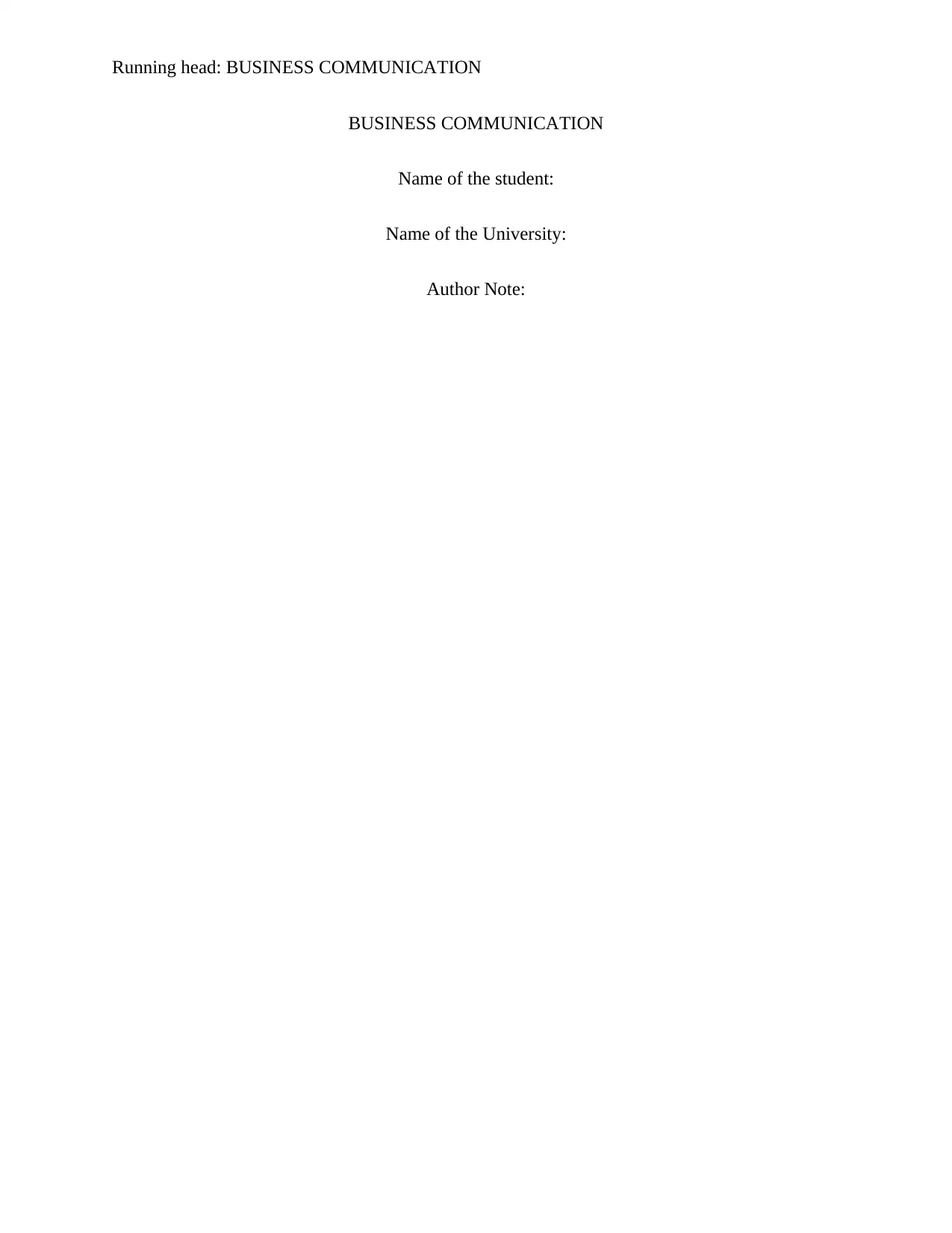
Running head: BUSINESS COMMUNICATION
BUSINESS COMMUNICATION
Name of the student:
Name of the University:
Author Note:
BUSINESS COMMUNICATION
Name of the student:
Name of the University:
Author Note:
Paraphrase This Document
Need a fresh take? Get an instant paraphrase of this document with our AI Paraphraser
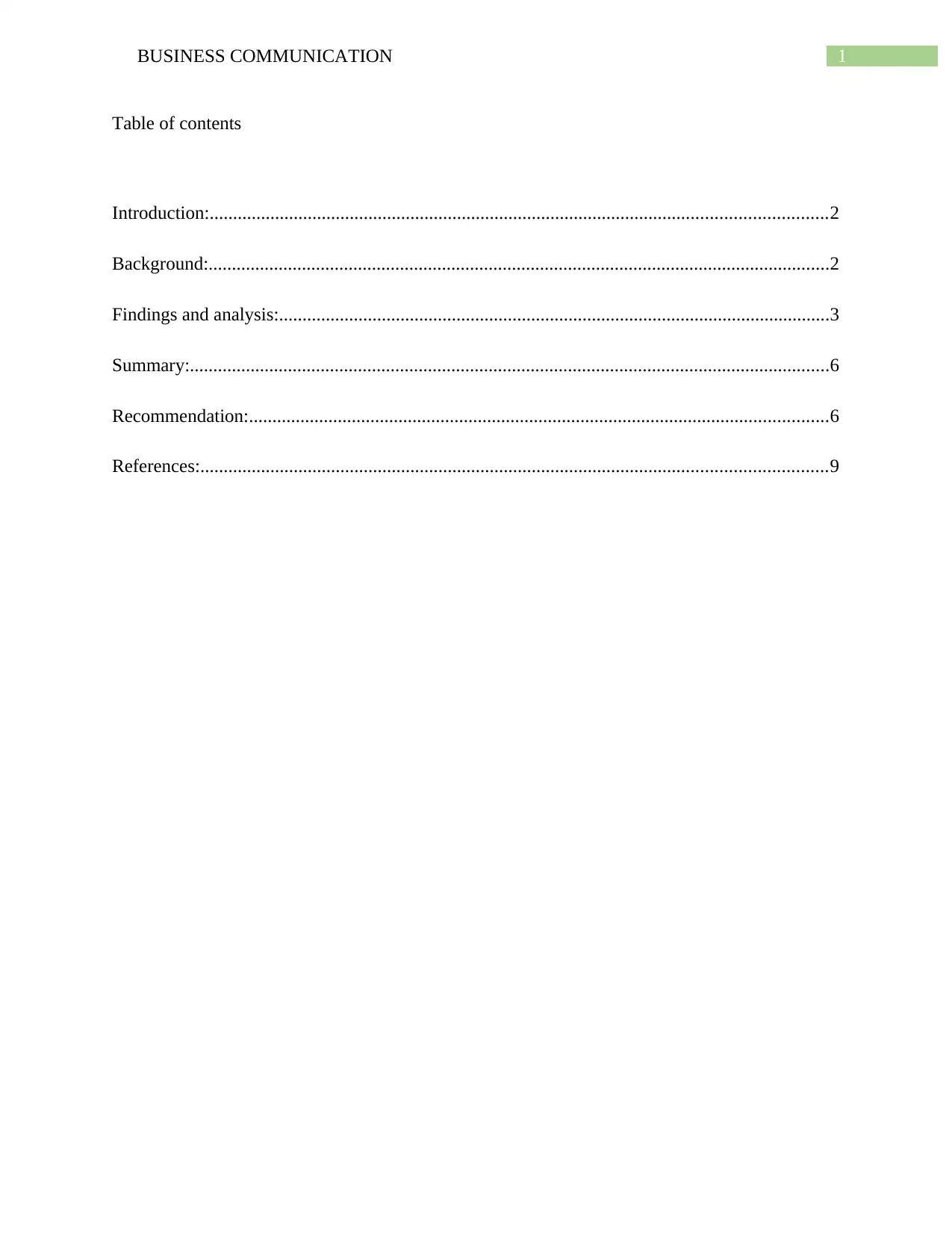
1BUSINESS COMMUNICATION
Table of contents
Introduction:....................................................................................................................................2
Background:.....................................................................................................................................2
Findings and analysis:......................................................................................................................3
Summary:.........................................................................................................................................6
Recommendation:............................................................................................................................6
References:......................................................................................................................................9
Table of contents
Introduction:....................................................................................................................................2
Background:.....................................................................................................................................2
Findings and analysis:......................................................................................................................3
Summary:.........................................................................................................................................6
Recommendation:............................................................................................................................6
References:......................................................................................................................................9
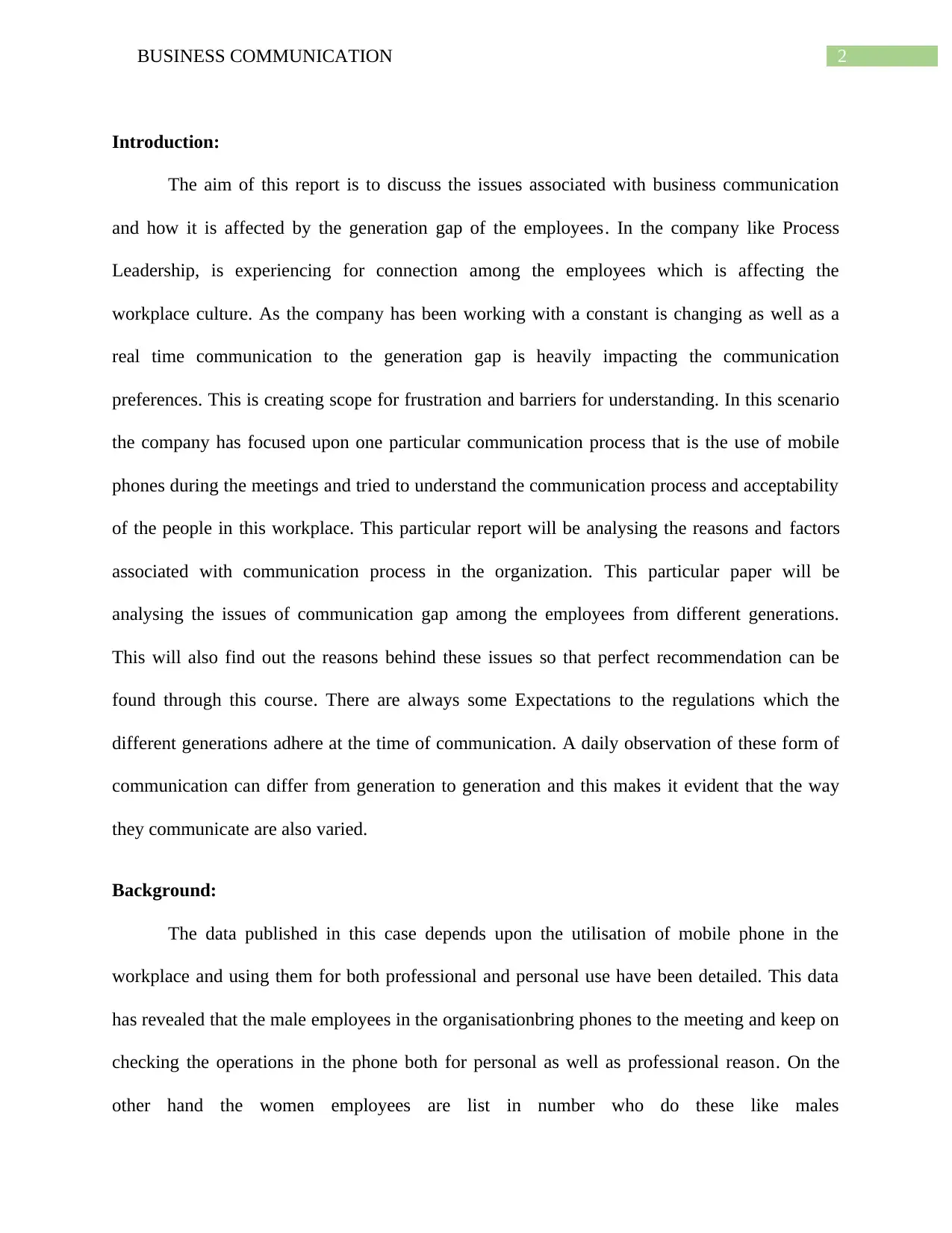
2BUSINESS COMMUNICATION
Introduction:
The aim of this report is to discuss the issues associated with business communication
and how it is affected by the generation gap of the employees. In the company like Process
Leadership, is experiencing for connection among the employees which is affecting the
workplace culture. As the company has been working with a constant is changing as well as a
real time communication to the generation gap is heavily impacting the communication
preferences. This is creating scope for frustration and barriers for understanding. In this scenario
the company has focused upon one particular communication process that is the use of mobile
phones during the meetings and tried to understand the communication process and acceptability
of the people in this workplace. This particular report will be analysing the reasons and factors
associated with communication process in the organization. This particular paper will be
analysing the issues of communication gap among the employees from different generations.
This will also find out the reasons behind these issues so that perfect recommendation can be
found through this course. There are always some Expectations to the regulations which the
different generations adhere at the time of communication. A daily observation of these form of
communication can differ from generation to generation and this makes it evident that the way
they communicate are also varied.
Background:
The data published in this case depends upon the utilisation of mobile phone in the
workplace and using them for both professional and personal use have been detailed. This data
has revealed that the male employees in the organisationbring phones to the meeting and keep on
checking the operations in the phone both for personal as well as professional reason. On the
other hand the women employees are list in number who do these like males
Introduction:
The aim of this report is to discuss the issues associated with business communication
and how it is affected by the generation gap of the employees. In the company like Process
Leadership, is experiencing for connection among the employees which is affecting the
workplace culture. As the company has been working with a constant is changing as well as a
real time communication to the generation gap is heavily impacting the communication
preferences. This is creating scope for frustration and barriers for understanding. In this scenario
the company has focused upon one particular communication process that is the use of mobile
phones during the meetings and tried to understand the communication process and acceptability
of the people in this workplace. This particular report will be analysing the reasons and factors
associated with communication process in the organization. This particular paper will be
analysing the issues of communication gap among the employees from different generations.
This will also find out the reasons behind these issues so that perfect recommendation can be
found through this course. There are always some Expectations to the regulations which the
different generations adhere at the time of communication. A daily observation of these form of
communication can differ from generation to generation and this makes it evident that the way
they communicate are also varied.
Background:
The data published in this case depends upon the utilisation of mobile phone in the
workplace and using them for both professional and personal use have been detailed. This data
has revealed that the male employees in the organisationbring phones to the meeting and keep on
checking the operations in the phone both for personal as well as professional reason. On the
other hand the women employees are list in number who do these like males
⊘ This is a preview!⊘
Do you want full access?
Subscribe today to unlock all pages.

Trusted by 1+ million students worldwide
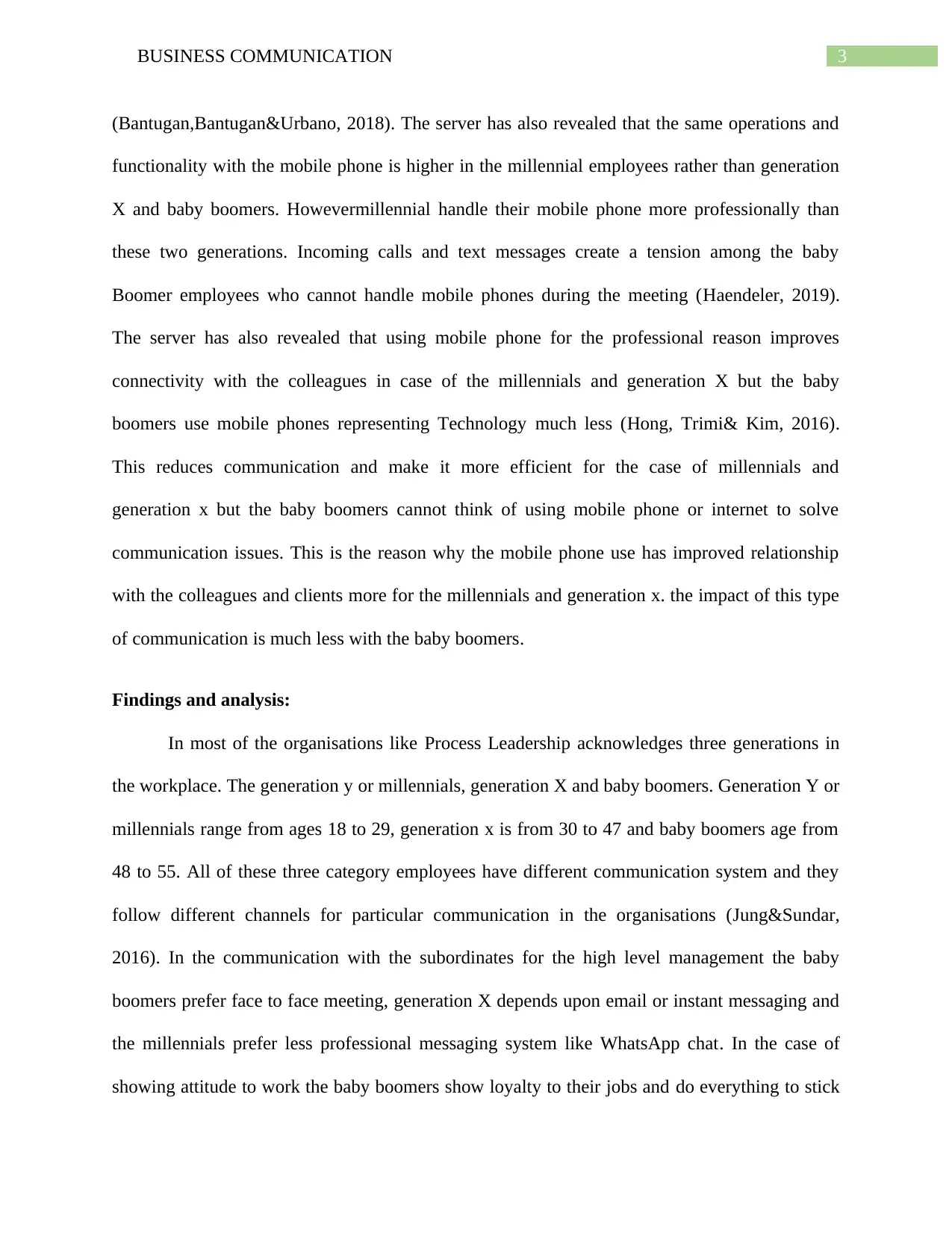
3BUSINESS COMMUNICATION
(Bantugan,Bantugan&Urbano, 2018). The server has also revealed that the same operations and
functionality with the mobile phone is higher in the millennial employees rather than generation
X and baby boomers. Howevermillennial handle their mobile phone more professionally than
these two generations. Incoming calls and text messages create a tension among the baby
Boomer employees who cannot handle mobile phones during the meeting (Haendeler, 2019).
The server has also revealed that using mobile phone for the professional reason improves
connectivity with the colleagues in case of the millennials and generation X but the baby
boomers use mobile phones representing Technology much less (Hong, Trimi& Kim, 2016).
This reduces communication and make it more efficient for the case of millennials and
generation x but the baby boomers cannot think of using mobile phone or internet to solve
communication issues. This is the reason why the mobile phone use has improved relationship
with the colleagues and clients more for the millennials and generation x. the impact of this type
of communication is much less with the baby boomers.
Findings and analysis:
In most of the organisations like Process Leadership acknowledges three generations in
the workplace. The generation y or millennials, generation X and baby boomers. Generation Y or
millennials range from ages 18 to 29, generation x is from 30 to 47 and baby boomers age from
48 to 55. All of these three category employees have different communication system and they
follow different channels for particular communication in the organisations (Jung&Sundar,
2016). In the communication with the subordinates for the high level management the baby
boomers prefer face to face meeting, generation X depends upon email or instant messaging and
the millennials prefer less professional messaging system like WhatsApp chat. In the case of
showing attitude to work the baby boomers show loyalty to their jobs and do everything to stick
(Bantugan,Bantugan&Urbano, 2018). The server has also revealed that the same operations and
functionality with the mobile phone is higher in the millennial employees rather than generation
X and baby boomers. Howevermillennial handle their mobile phone more professionally than
these two generations. Incoming calls and text messages create a tension among the baby
Boomer employees who cannot handle mobile phones during the meeting (Haendeler, 2019).
The server has also revealed that using mobile phone for the professional reason improves
connectivity with the colleagues in case of the millennials and generation X but the baby
boomers use mobile phones representing Technology much less (Hong, Trimi& Kim, 2016).
This reduces communication and make it more efficient for the case of millennials and
generation x but the baby boomers cannot think of using mobile phone or internet to solve
communication issues. This is the reason why the mobile phone use has improved relationship
with the colleagues and clients more for the millennials and generation x. the impact of this type
of communication is much less with the baby boomers.
Findings and analysis:
In most of the organisations like Process Leadership acknowledges three generations in
the workplace. The generation y or millennials, generation X and baby boomers. Generation Y or
millennials range from ages 18 to 29, generation x is from 30 to 47 and baby boomers age from
48 to 55. All of these three category employees have different communication system and they
follow different channels for particular communication in the organisations (Jung&Sundar,
2016). In the communication with the subordinates for the high level management the baby
boomers prefer face to face meeting, generation X depends upon email or instant messaging and
the millennials prefer less professional messaging system like WhatsApp chat. In the case of
showing attitude to work the baby boomers show loyalty to their jobs and do everything to stick
Paraphrase This Document
Need a fresh take? Get an instant paraphrase of this document with our AI Paraphraser
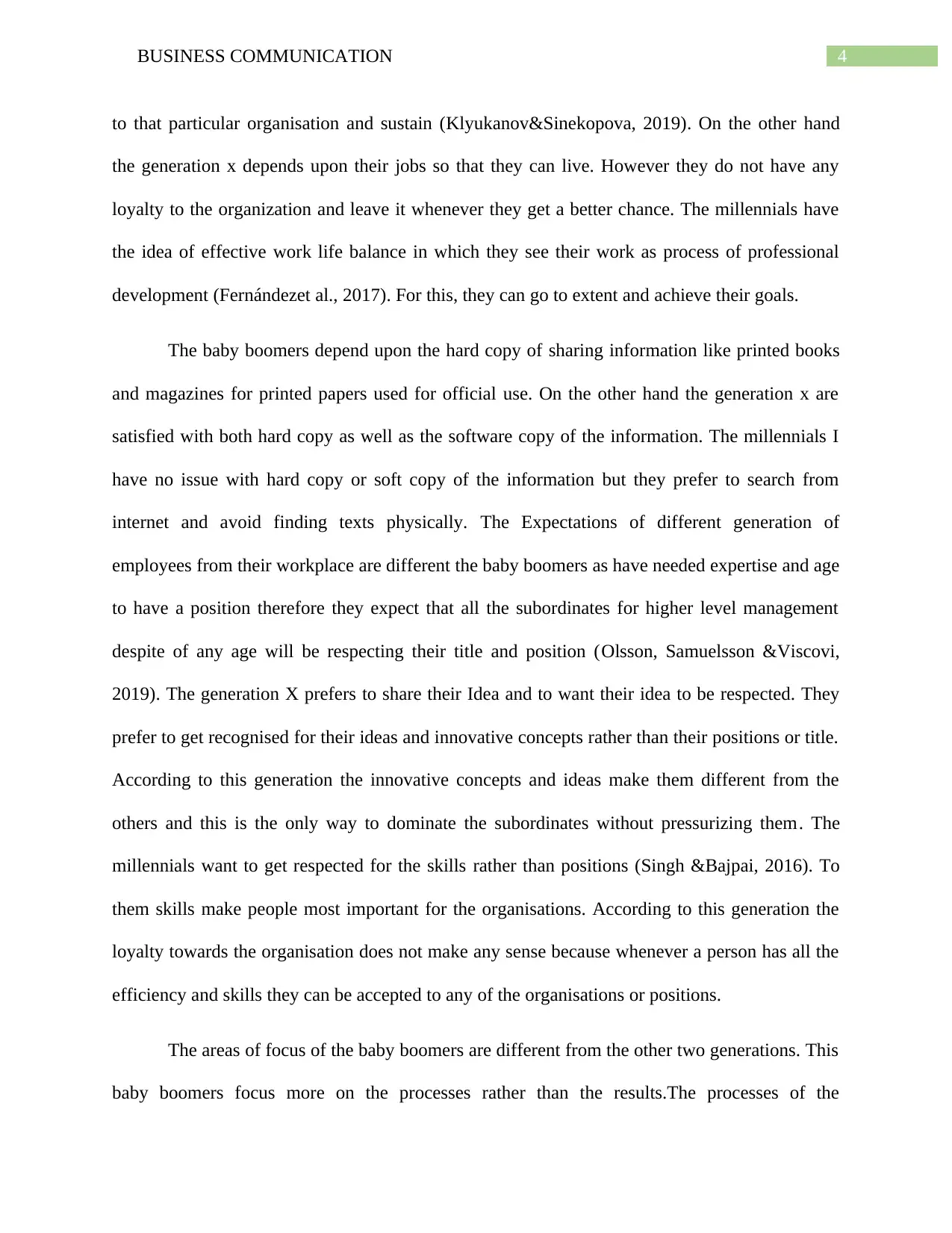
4BUSINESS COMMUNICATION
to that particular organisation and sustain (Klyukanov&Sinekopova, 2019). On the other hand
the generation x depends upon their jobs so that they can live. However they do not have any
loyalty to the organization and leave it whenever they get a better chance. The millennials have
the idea of effective work life balance in which they see their work as process of professional
development (Fernándezet al., 2017). For this, they can go to extent and achieve their goals.
The baby boomers depend upon the hard copy of sharing information like printed books
and magazines for printed papers used for official use. On the other hand the generation x are
satisfied with both hard copy as well as the software copy of the information. The millennials I
have no issue with hard copy or soft copy of the information but they prefer to search from
internet and avoid finding texts physically. The Expectations of different generation of
employees from their workplace are different the baby boomers as have needed expertise and age
to have a position therefore they expect that all the subordinates for higher level management
despite of any age will be respecting their title and position (Olsson, Samuelsson &Viscovi,
2019). The generation X prefers to share their Idea and to want their idea to be respected. They
prefer to get recognised for their ideas and innovative concepts rather than their positions or title.
According to this generation the innovative concepts and ideas make them different from the
others and this is the only way to dominate the subordinates without pressurizing them. The
millennials want to get respected for the skills rather than positions (Singh &Bajpai, 2016). To
them skills make people most important for the organisations. According to this generation the
loyalty towards the organisation does not make any sense because whenever a person has all the
efficiency and skills they can be accepted to any of the organisations or positions.
The areas of focus of the baby boomers are different from the other two generations. This
baby boomers focus more on the processes rather than the results.The processes of the
to that particular organisation and sustain (Klyukanov&Sinekopova, 2019). On the other hand
the generation x depends upon their jobs so that they can live. However they do not have any
loyalty to the organization and leave it whenever they get a better chance. The millennials have
the idea of effective work life balance in which they see their work as process of professional
development (Fernándezet al., 2017). For this, they can go to extent and achieve their goals.
The baby boomers depend upon the hard copy of sharing information like printed books
and magazines for printed papers used for official use. On the other hand the generation x are
satisfied with both hard copy as well as the software copy of the information. The millennials I
have no issue with hard copy or soft copy of the information but they prefer to search from
internet and avoid finding texts physically. The Expectations of different generation of
employees from their workplace are different the baby boomers as have needed expertise and age
to have a position therefore they expect that all the subordinates for higher level management
despite of any age will be respecting their title and position (Olsson, Samuelsson &Viscovi,
2019). The generation X prefers to share their Idea and to want their idea to be respected. They
prefer to get recognised for their ideas and innovative concepts rather than their positions or title.
According to this generation the innovative concepts and ideas make them different from the
others and this is the only way to dominate the subordinates without pressurizing them. The
millennials want to get respected for the skills rather than positions (Singh &Bajpai, 2016). To
them skills make people most important for the organisations. According to this generation the
loyalty towards the organisation does not make any sense because whenever a person has all the
efficiency and skills they can be accepted to any of the organisations or positions.
The areas of focus of the baby boomers are different from the other two generations. This
baby boomers focus more on the processes rather than the results.The processes of the
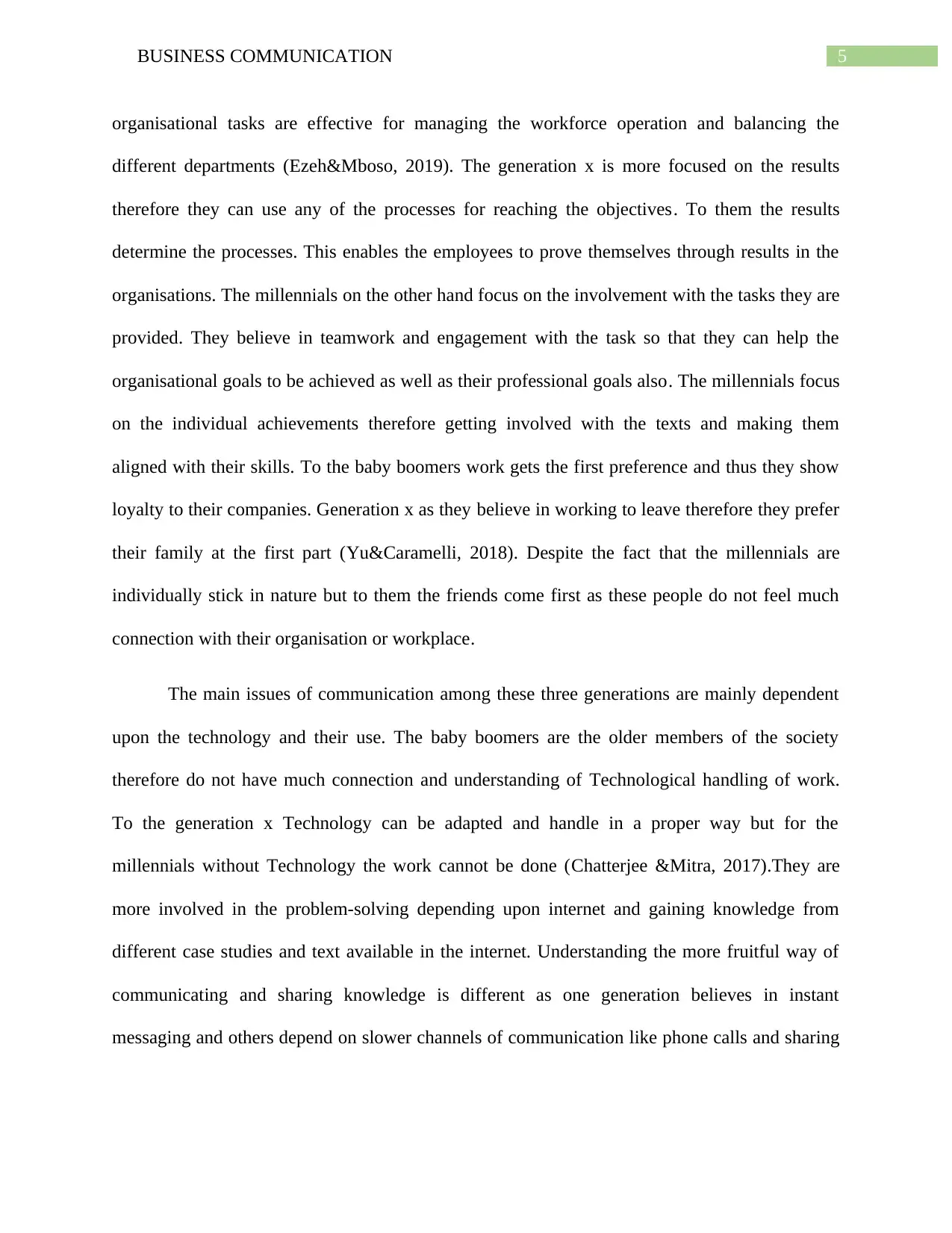
5BUSINESS COMMUNICATION
organisational tasks are effective for managing the workforce operation and balancing the
different departments (Ezeh&Mboso, 2019). The generation x is more focused on the results
therefore they can use any of the processes for reaching the objectives. To them the results
determine the processes. This enables the employees to prove themselves through results in the
organisations. The millennials on the other hand focus on the involvement with the tasks they are
provided. They believe in teamwork and engagement with the task so that they can help the
organisational goals to be achieved as well as their professional goals also. The millennials focus
on the individual achievements therefore getting involved with the texts and making them
aligned with their skills. To the baby boomers work gets the first preference and thus they show
loyalty to their companies. Generation x as they believe in working to leave therefore they prefer
their family at the first part (Yu&Caramelli, 2018). Despite the fact that the millennials are
individually stick in nature but to them the friends come first as these people do not feel much
connection with their organisation or workplace.
The main issues of communication among these three generations are mainly dependent
upon the technology and their use. The baby boomers are the older members of the society
therefore do not have much connection and understanding of Technological handling of work.
To the generation x Technology can be adapted and handle in a proper way but for the
millennials without Technology the work cannot be done (Chatterjee &Mitra, 2017).They are
more involved in the problem-solving depending upon internet and gaining knowledge from
different case studies and text available in the internet. Understanding the more fruitful way of
communicating and sharing knowledge is different as one generation believes in instant
messaging and others depend on slower channels of communication like phone calls and sharing
organisational tasks are effective for managing the workforce operation and balancing the
different departments (Ezeh&Mboso, 2019). The generation x is more focused on the results
therefore they can use any of the processes for reaching the objectives. To them the results
determine the processes. This enables the employees to prove themselves through results in the
organisations. The millennials on the other hand focus on the involvement with the tasks they are
provided. They believe in teamwork and engagement with the task so that they can help the
organisational goals to be achieved as well as their professional goals also. The millennials focus
on the individual achievements therefore getting involved with the texts and making them
aligned with their skills. To the baby boomers work gets the first preference and thus they show
loyalty to their companies. Generation x as they believe in working to leave therefore they prefer
their family at the first part (Yu&Caramelli, 2018). Despite the fact that the millennials are
individually stick in nature but to them the friends come first as these people do not feel much
connection with their organisation or workplace.
The main issues of communication among these three generations are mainly dependent
upon the technology and their use. The baby boomers are the older members of the society
therefore do not have much connection and understanding of Technological handling of work.
To the generation x Technology can be adapted and handle in a proper way but for the
millennials without Technology the work cannot be done (Chatterjee &Mitra, 2017).They are
more involved in the problem-solving depending upon internet and gaining knowledge from
different case studies and text available in the internet. Understanding the more fruitful way of
communicating and sharing knowledge is different as one generation believes in instant
messaging and others depend on slower channels of communication like phone calls and sharing
⊘ This is a preview!⊘
Do you want full access?
Subscribe today to unlock all pages.

Trusted by 1+ million students worldwide
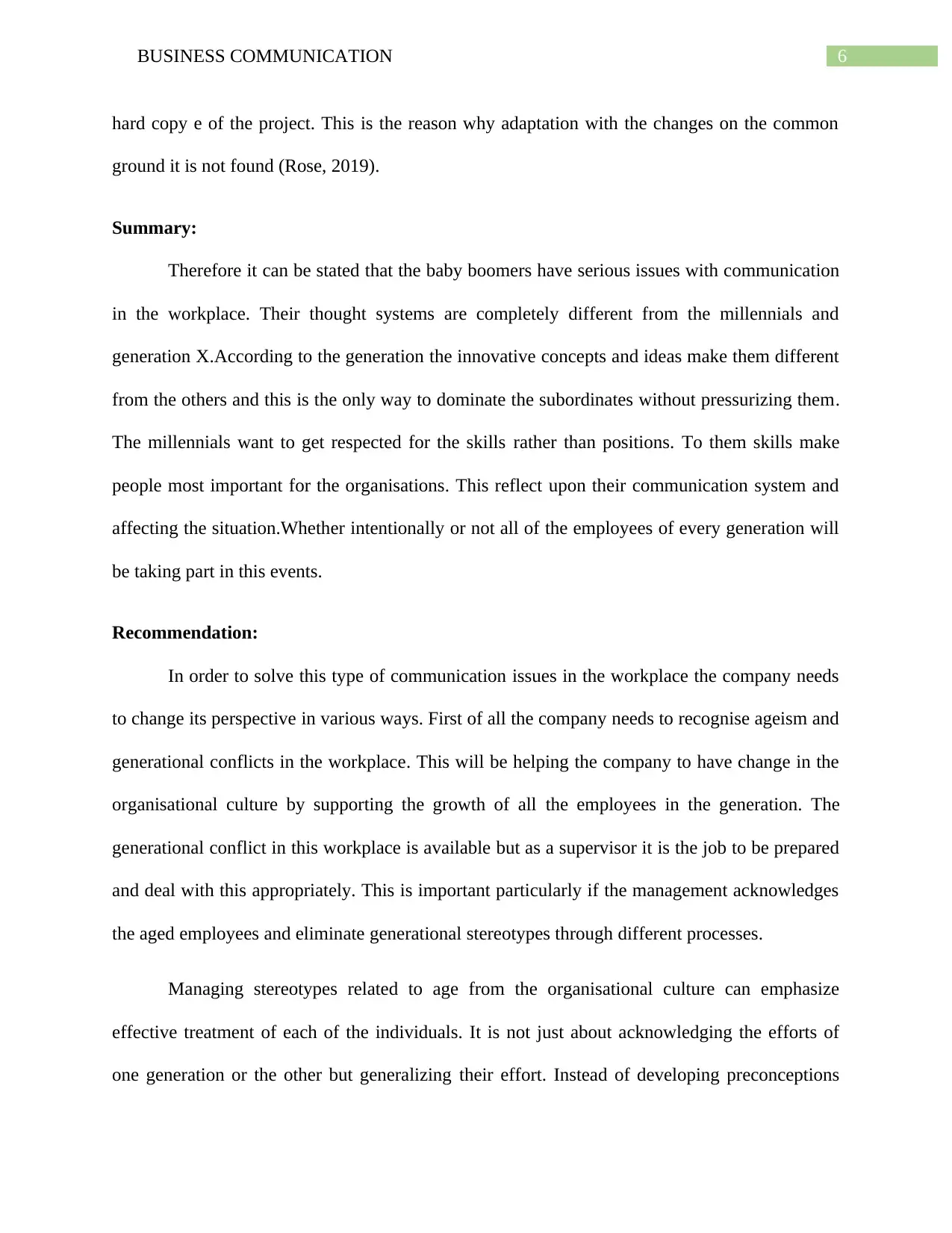
6BUSINESS COMMUNICATION
hard copy e of the project. This is the reason why adaptation with the changes on the common
ground it is not found (Rose, 2019).
Summary:
Therefore it can be stated that the baby boomers have serious issues with communication
in the workplace. Their thought systems are completely different from the millennials and
generation X.According to the generation the innovative concepts and ideas make them different
from the others and this is the only way to dominate the subordinates without pressurizing them.
The millennials want to get respected for the skills rather than positions. To them skills make
people most important for the organisations. This reflect upon their communication system and
affecting the situation.Whether intentionally or not all of the employees of every generation will
be taking part in this events.
Recommendation:
In order to solve this type of communication issues in the workplace the company needs
to change its perspective in various ways. First of all the company needs to recognise ageism and
generational conflicts in the workplace. This will be helping the company to have change in the
organisational culture by supporting the growth of all the employees in the generation. The
generational conflict in this workplace is available but as a supervisor it is the job to be prepared
and deal with this appropriately. This is important particularly if the management acknowledges
the aged employees and eliminate generational stereotypes through different processes.
Managing stereotypes related to age from the organisational culture can emphasize
effective treatment of each of the individuals. It is not just about acknowledging the efforts of
one generation or the other but generalizing their effort. Instead of developing preconceptions
hard copy e of the project. This is the reason why adaptation with the changes on the common
ground it is not found (Rose, 2019).
Summary:
Therefore it can be stated that the baby boomers have serious issues with communication
in the workplace. Their thought systems are completely different from the millennials and
generation X.According to the generation the innovative concepts and ideas make them different
from the others and this is the only way to dominate the subordinates without pressurizing them.
The millennials want to get respected for the skills rather than positions. To them skills make
people most important for the organisations. This reflect upon their communication system and
affecting the situation.Whether intentionally or not all of the employees of every generation will
be taking part in this events.
Recommendation:
In order to solve this type of communication issues in the workplace the company needs
to change its perspective in various ways. First of all the company needs to recognise ageism and
generational conflicts in the workplace. This will be helping the company to have change in the
organisational culture by supporting the growth of all the employees in the generation. The
generational conflict in this workplace is available but as a supervisor it is the job to be prepared
and deal with this appropriately. This is important particularly if the management acknowledges
the aged employees and eliminate generational stereotypes through different processes.
Managing stereotypes related to age from the organisational culture can emphasize
effective treatment of each of the individuals. It is not just about acknowledging the efforts of
one generation or the other but generalizing their effort. Instead of developing preconceptions
Paraphrase This Document
Need a fresh take? Get an instant paraphrase of this document with our AI Paraphraser
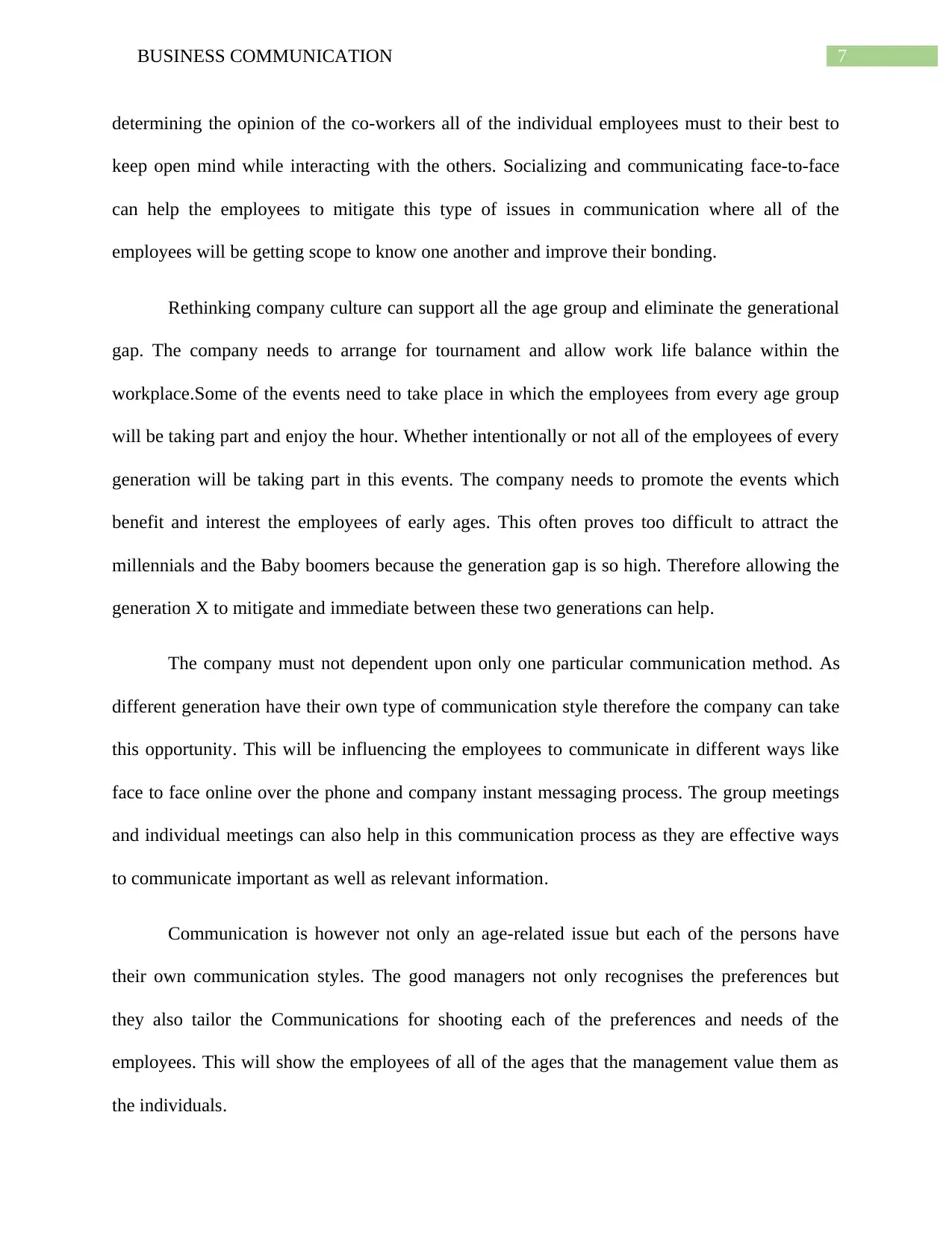
7BUSINESS COMMUNICATION
determining the opinion of the co-workers all of the individual employees must to their best to
keep open mind while interacting with the others. Socializing and communicating face-to-face
can help the employees to mitigate this type of issues in communication where all of the
employees will be getting scope to know one another and improve their bonding.
Rethinking company culture can support all the age group and eliminate the generational
gap. The company needs to arrange for tournament and allow work life balance within the
workplace.Some of the events need to take place in which the employees from every age group
will be taking part and enjoy the hour. Whether intentionally or not all of the employees of every
generation will be taking part in this events. The company needs to promote the events which
benefit and interest the employees of early ages. This often proves too difficult to attract the
millennials and the Baby boomers because the generation gap is so high. Therefore allowing the
generation X to mitigate and immediate between these two generations can help.
The company must not dependent upon only one particular communication method. As
different generation have their own type of communication style therefore the company can take
this opportunity. This will be influencing the employees to communicate in different ways like
face to face online over the phone and company instant messaging process. The group meetings
and individual meetings can also help in this communication process as they are effective ways
to communicate important as well as relevant information.
Communication is however not only an age-related issue but each of the persons have
their own communication styles. The good managers not only recognises the preferences but
they also tailor the Communications for shooting each of the preferences and needs of the
employees. This will show the employees of all of the ages that the management value them as
the individuals.
determining the opinion of the co-workers all of the individual employees must to their best to
keep open mind while interacting with the others. Socializing and communicating face-to-face
can help the employees to mitigate this type of issues in communication where all of the
employees will be getting scope to know one another and improve their bonding.
Rethinking company culture can support all the age group and eliminate the generational
gap. The company needs to arrange for tournament and allow work life balance within the
workplace.Some of the events need to take place in which the employees from every age group
will be taking part and enjoy the hour. Whether intentionally or not all of the employees of every
generation will be taking part in this events. The company needs to promote the events which
benefit and interest the employees of early ages. This often proves too difficult to attract the
millennials and the Baby boomers because the generation gap is so high. Therefore allowing the
generation X to mitigate and immediate between these two generations can help.
The company must not dependent upon only one particular communication method. As
different generation have their own type of communication style therefore the company can take
this opportunity. This will be influencing the employees to communicate in different ways like
face to face online over the phone and company instant messaging process. The group meetings
and individual meetings can also help in this communication process as they are effective ways
to communicate important as well as relevant information.
Communication is however not only an age-related issue but each of the persons have
their own communication styles. The good managers not only recognises the preferences but
they also tailor the Communications for shooting each of the preferences and needs of the
employees. This will show the employees of all of the ages that the management value them as
the individuals.
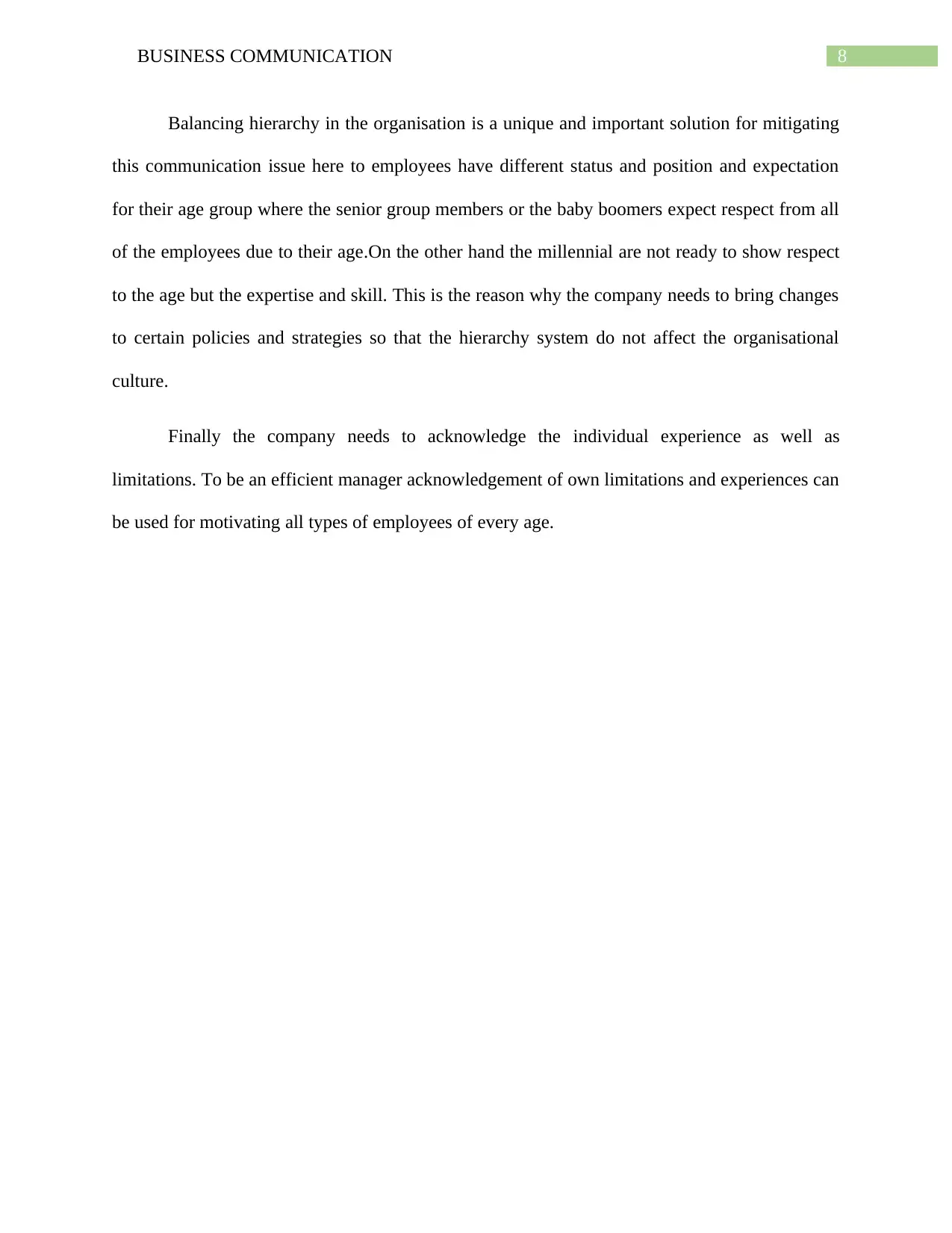
8BUSINESS COMMUNICATION
Balancing hierarchy in the organisation is a unique and important solution for mitigating
this communication issue here to employees have different status and position and expectation
for their age group where the senior group members or the baby boomers expect respect from all
of the employees due to their age.On the other hand the millennial are not ready to show respect
to the age but the expertise and skill. This is the reason why the company needs to bring changes
to certain policies and strategies so that the hierarchy system do not affect the organisational
culture.
Finally the company needs to acknowledge the individual experience as well as
limitations. To be an efficient manager acknowledgement of own limitations and experiences can
be used for motivating all types of employees of every age.
Balancing hierarchy in the organisation is a unique and important solution for mitigating
this communication issue here to employees have different status and position and expectation
for their age group where the senior group members or the baby boomers expect respect from all
of the employees due to their age.On the other hand the millennial are not ready to show respect
to the age but the expertise and skill. This is the reason why the company needs to bring changes
to certain policies and strategies so that the hierarchy system do not affect the organisational
culture.
Finally the company needs to acknowledge the individual experience as well as
limitations. To be an efficient manager acknowledgement of own limitations and experiences can
be used for motivating all types of employees of every age.
⊘ This is a preview!⊘
Do you want full access?
Subscribe today to unlock all pages.

Trusted by 1+ million students worldwide
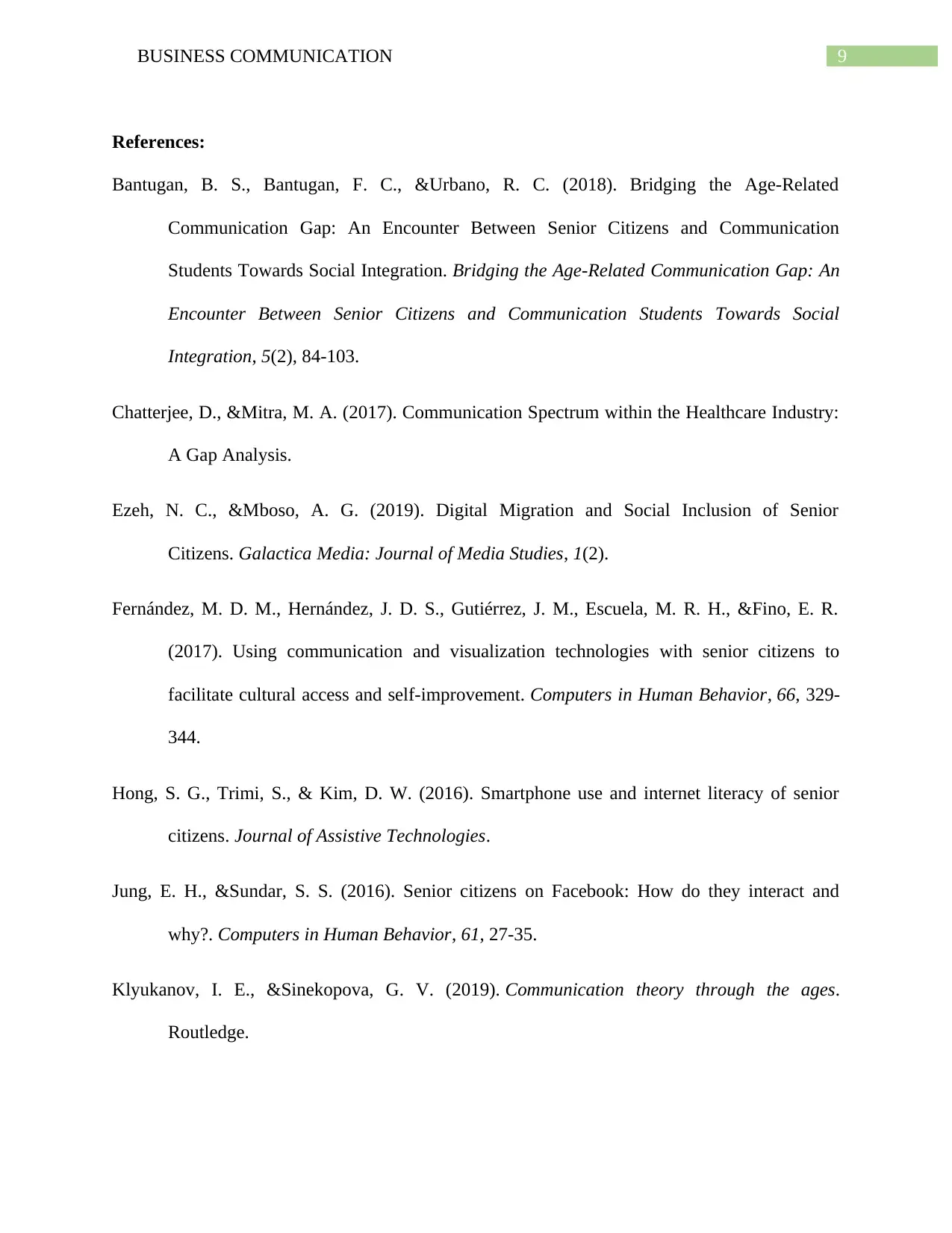
9BUSINESS COMMUNICATION
References:
Bantugan, B. S., Bantugan, F. C., &Urbano, R. C. (2018). Bridging the Age-Related
Communication Gap: An Encounter Between Senior Citizens and Communication
Students Towards Social Integration. Bridging the Age-Related Communication Gap: An
Encounter Between Senior Citizens and Communication Students Towards Social
Integration, 5(2), 84-103.
Chatterjee, D., &Mitra, M. A. (2017). Communication Spectrum within the Healthcare Industry:
A Gap Analysis.
Ezeh, N. C., &Mboso, A. G. (2019). Digital Migration and Social Inclusion of Senior
Citizens. Galactica Media: Journal of Media Studies, 1(2).
Fernández, M. D. M., Hernández, J. D. S., Gutiérrez, J. M., Escuela, M. R. H., &Fino, E. R.
(2017). Using communication and visualization technologies with senior citizens to
facilitate cultural access and self-improvement. Computers in Human Behavior, 66, 329-
344.
Hong, S. G., Trimi, S., & Kim, D. W. (2016). Smartphone use and internet literacy of senior
citizens. Journal of Assistive Technologies.
Jung, E. H., &Sundar, S. S. (2016). Senior citizens on Facebook: How do they interact and
why?. Computers in Human Behavior, 61, 27-35.
Klyukanov, I. E., &Sinekopova, G. V. (2019). Communication theory through the ages.
Routledge.
References:
Bantugan, B. S., Bantugan, F. C., &Urbano, R. C. (2018). Bridging the Age-Related
Communication Gap: An Encounter Between Senior Citizens and Communication
Students Towards Social Integration. Bridging the Age-Related Communication Gap: An
Encounter Between Senior Citizens and Communication Students Towards Social
Integration, 5(2), 84-103.
Chatterjee, D., &Mitra, M. A. (2017). Communication Spectrum within the Healthcare Industry:
A Gap Analysis.
Ezeh, N. C., &Mboso, A. G. (2019). Digital Migration and Social Inclusion of Senior
Citizens. Galactica Media: Journal of Media Studies, 1(2).
Fernández, M. D. M., Hernández, J. D. S., Gutiérrez, J. M., Escuela, M. R. H., &Fino, E. R.
(2017). Using communication and visualization technologies with senior citizens to
facilitate cultural access and self-improvement. Computers in Human Behavior, 66, 329-
344.
Hong, S. G., Trimi, S., & Kim, D. W. (2016). Smartphone use and internet literacy of senior
citizens. Journal of Assistive Technologies.
Jung, E. H., &Sundar, S. S. (2016). Senior citizens on Facebook: How do they interact and
why?. Computers in Human Behavior, 61, 27-35.
Klyukanov, I. E., &Sinekopova, G. V. (2019). Communication theory through the ages.
Routledge.
Paraphrase This Document
Need a fresh take? Get an instant paraphrase of this document with our AI Paraphraser
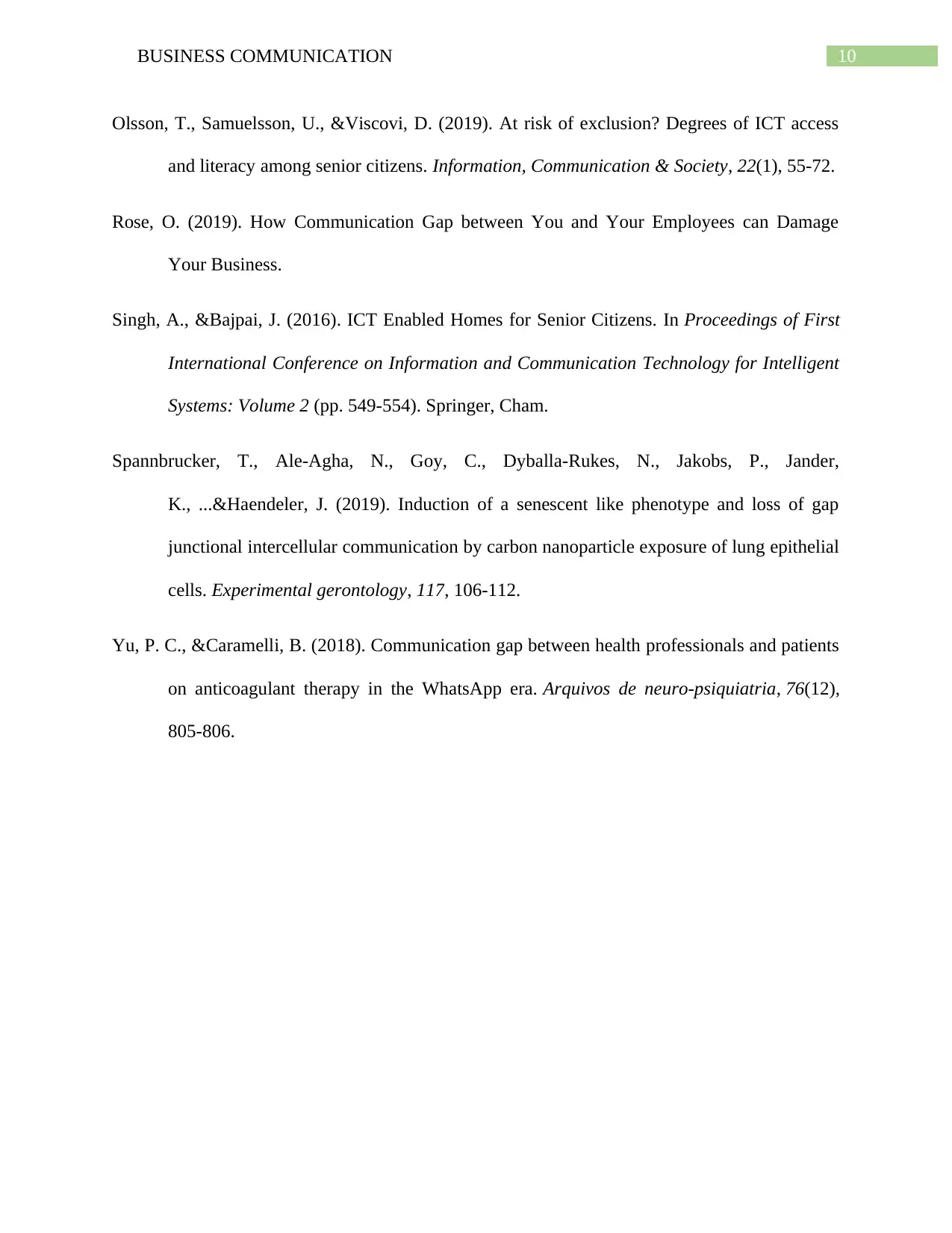
10BUSINESS COMMUNICATION
Olsson, T., Samuelsson, U., &Viscovi, D. (2019). At risk of exclusion? Degrees of ICT access
and literacy among senior citizens. Information, Communication & Society, 22(1), 55-72.
Rose, O. (2019). How Communication Gap between You and Your Employees can Damage
Your Business.
Singh, A., &Bajpai, J. (2016). ICT Enabled Homes for Senior Citizens. In Proceedings of First
International Conference on Information and Communication Technology for Intelligent
Systems: Volume 2 (pp. 549-554). Springer, Cham.
Spannbrucker, T., Ale-Agha, N., Goy, C., Dyballa-Rukes, N., Jakobs, P., Jander,
K., ...&Haendeler, J. (2019). Induction of a senescent like phenotype and loss of gap
junctional intercellular communication by carbon nanoparticle exposure of lung epithelial
cells. Experimental gerontology, 117, 106-112.
Yu, P. C., &Caramelli, B. (2018). Communication gap between health professionals and patients
on anticoagulant therapy in the WhatsApp era. Arquivos de neuro-psiquiatria, 76(12),
805-806.
Olsson, T., Samuelsson, U., &Viscovi, D. (2019). At risk of exclusion? Degrees of ICT access
and literacy among senior citizens. Information, Communication & Society, 22(1), 55-72.
Rose, O. (2019). How Communication Gap between You and Your Employees can Damage
Your Business.
Singh, A., &Bajpai, J. (2016). ICT Enabled Homes for Senior Citizens. In Proceedings of First
International Conference on Information and Communication Technology for Intelligent
Systems: Volume 2 (pp. 549-554). Springer, Cham.
Spannbrucker, T., Ale-Agha, N., Goy, C., Dyballa-Rukes, N., Jakobs, P., Jander,
K., ...&Haendeler, J. (2019). Induction of a senescent like phenotype and loss of gap
junctional intercellular communication by carbon nanoparticle exposure of lung epithelial
cells. Experimental gerontology, 117, 106-112.
Yu, P. C., &Caramelli, B. (2018). Communication gap between health professionals and patients
on anticoagulant therapy in the WhatsApp era. Arquivos de neuro-psiquiatria, 76(12),
805-806.
1 out of 11
Related Documents
Your All-in-One AI-Powered Toolkit for Academic Success.
+13062052269
info@desklib.com
Available 24*7 on WhatsApp / Email
![[object Object]](/_next/static/media/star-bottom.7253800d.svg)
Unlock your academic potential
Copyright © 2020–2025 A2Z Services. All Rights Reserved. Developed and managed by ZUCOL.





